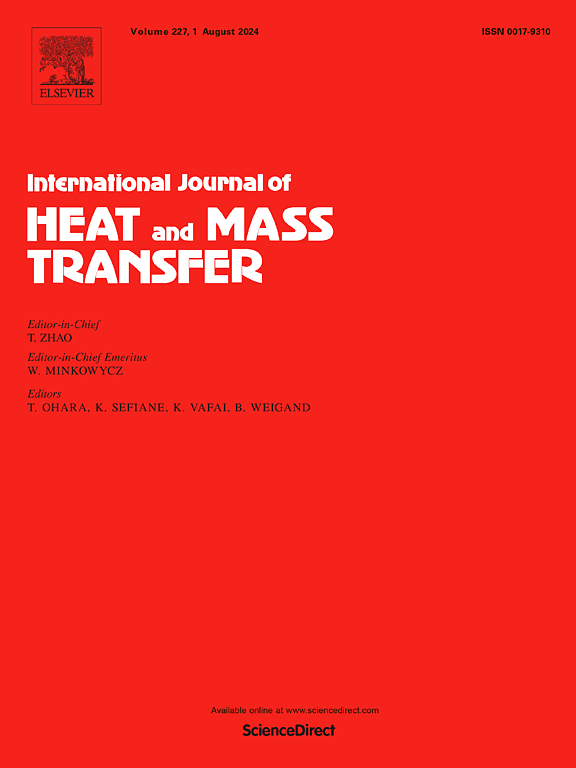用于不规则设计域大功率正热力系数加热器的液体冷却微通道的多目标拓扑优化
IF 5
2区 工程技术
Q1 ENGINEERING, MECHANICAL
International Journal of Heat and Mass Transfer
Pub Date : 2024-11-25
DOI:10.1016/j.ijheatmasstransfer.2024.126422
引用次数: 0
摘要
高功率密度电子设备需要紧凑高效的冷却系统。本文采用多目标拓扑优化方法,为具有不规则设计域的大功率正热系数加热器设计液体冷却通道。该优化方法旨在同时实现功耗最小化和总发热量最大化。通过比较带有针形鳍片的蛇形通道的实验结果,验证了数值分析的准确性。平均温度和压降的最大相对误差分别为 6.9 % 和 18.6 %。模拟的加热电阻温度等值线与实验结果非常吻合。与 4 种传统设计相比,优化设计在液压和热性能方面表现出最佳的整体性能。结果表明,拓扑优化通道的温度均匀性最好,平均温度最低,比其他设计低 10 ℃ 以上。此外,拓扑通道还具有与平行通道相当的低压降。此外,还研究了雷诺数、流体体积分数和加权因子对拓扑结果的影响。结果表明,增加雷诺数或流体体积分数会扩大冷却通道面积,产生更多小分支,从而提高热性能。就本研究的具体情况而言,热目标和液压目标的加权系数对拓扑结果影响较小。本文章由计算机程序翻译,如有差异,请以英文原文为准。

Multi-objective topology optimization of a liquid-cooled microchannel for high power positive thermal coefficient heater with irregular design domain
High power density electronic devices require compact and efficient cooling systems. In this paper, a multi-objective topology optimization method is employed to design the liquid-cooled channel for a high power positive thermal coefficient heater with an irregular design domain. The optimization seeks to simultaneously minimize power consumption and maximize total heat generation. The accuracy of the numerical analysis is validated by comparing the experimental results of the serpentine channel with pin fins. The maximum relative errors in average temperature and pressure drop are 6.9 % and 18.6 %, respectively. The simulated temperature contours of the heating resistance closely match the experimental results. Compared with 4 conventional designs, the optimized design shows best overall performance in hydraulic and thermal performance. The results demonstrate that the topology optimized channel exhibits the best temperature uniformity and achieves the lowest average temperature, more than 10 °C lower than other designs. Furthermore, the topological channel exhibits a low pressure drop comparable to that of parallel channels. Moreover, the effects of the Reynolds number, fluid volume fraction and weighting factors on the topology results are investigated. The results indicate increasing the Reynolds number or the fluid volume fraction will expand the cooling channel area and generate more small branches, thereby enhancing thermal performance. For the specific case in this study, the weighting factors of the thermal and hydraulic objectives have slight impact on the topology results.
求助全文
通过发布文献求助,成功后即可免费获取论文全文。
去求助
来源期刊
CiteScore
10.30
自引率
13.50%
发文量
1319
审稿时长
41 days
期刊介绍:
International Journal of Heat and Mass Transfer is the vehicle for the exchange of basic ideas in heat and mass transfer between research workers and engineers throughout the world. It focuses on both analytical and experimental research, with an emphasis on contributions which increase the basic understanding of transfer processes and their application to engineering problems.
Topics include:
-New methods of measuring and/or correlating transport-property data
-Energy engineering
-Environmental applications of heat and/or mass transfer

 求助内容:
求助内容: 应助结果提醒方式:
应助结果提醒方式:


